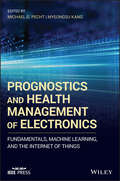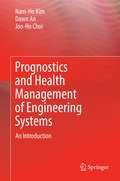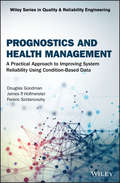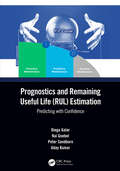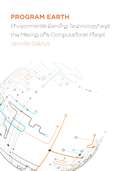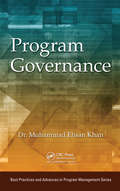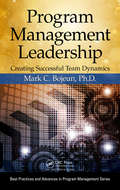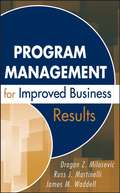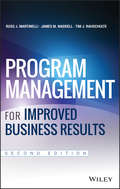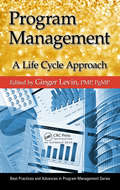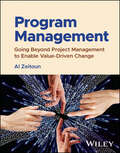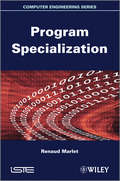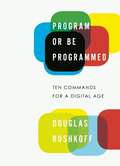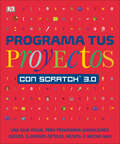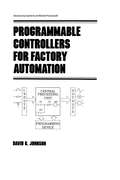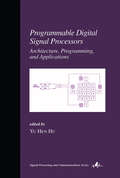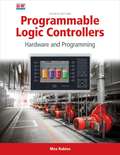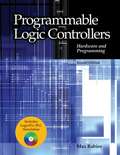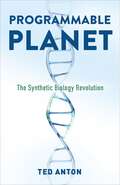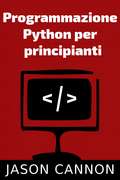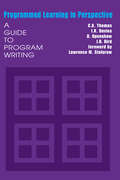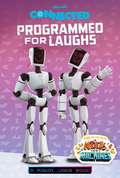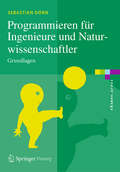- Table View
- List View
Prognostics and Health Management of Electronics: Fundamentals, Machine Learning, and the Internet of Things (Wiley - IEEE)
by Michael G. Pecht Myeongsu KangAn indispensable guide for engineers and data scientists in design, testing, operation, manufacturing, and maintenance A road map to the current challenges and available opportunities for the research and development of Prognostics and Health Management (PHM), this important work covers all areas of electronics and explains how to: assess methods for damage estimation of components and systems due to field loading conditions assess the cost and benefits of prognostic implementations develop novel methods for in situ monitoring of products and systems in actual life-cycle conditions enable condition-based (predictive) maintenance increase system availability through an extension of maintenance cycles and/or timely repair actions; obtain knowledge of load history for future design, qualification, and root cause analysis reduce the occurrence of no fault found (NFF) subtract life-cycle costs of equipment from reduction in inspection costs, downtime, and inventory Prognostics and Health Management of Electronics also explains how to understand statistical techniques and machine learning methods used for diagnostics and prognostics. Using this valuable resource, electrical engineers, data scientists, and design engineers will be able to fully grasp the synergy between IoT, machine learning, and risk assessment.
Prognostics and Health Management of Engineering Systems
by Nam-Ho Kim Dawn An Joo-Ho ChoiThis book introduces the methods for predicting the future behavior of a system's health and the remaining useful life to determine an appropriate maintenance schedule. The authors introduce the history, industrial applications, algorithms, and benefits and challenges of PHM (Prognostics and Health Management) to help readers understand this highly interdisciplinary engineering approach that incorporates sensing technologies, physics of failure, machine learning, modern statistics, and reliability engineering. It is ideal for beginners because it introduces various prognostics algorithms and explains their attributes, pros and cons in terms of model definition, model parameter estimation, and ability to handle noise and bias in data, allowing readers to select the appropriate methods for their fields of application. Among the many topics discussed in-depth are: * Prognostics tutorials using least-squares * Bayesian inference and parameter estimation * Physics-based prognostics algorithms including nonlinear least squares, Bayesian method, and particle filter * Data-driven prognostics algorithms including Gaussian process regression and neural network * Comparison of different prognostics algorithms The authors also present several applications of prognostics in practical engineering systems, including wear in a revolute joint, fatigue crack growth in a panel, prognostics using accelerated life test data, fatigue damage in bearings, and more. Prognostics tutorials with a Matlab code using simple examples are provided, along with a companion website that presents Matlab programs for different algorithms as well as measurement data. Each chapter contains a comprehensive set of exercise problems, some of which require Matlab programs, making this an ideal book for graduate students in mechanical, civil, aerospace, electrical, and industrial engineering and engineering mechanics, as well as researchers and maintenance engineers in the above fields.
Prognostics and Health Management: A Practical Approach to Improving System Reliability Using Condition-Based Data (Quality and Reliability Engineering Series)
by Ferenc Szidarovszky Douglas Goodman James P. HofmeisterA comprehensive guide to the application and processing of condition-based data to produce prognostic estimates of functional health and life. Prognostics and Health Management provides an authoritative guide for an understanding of the rationale and methodologies of a practical approach for improving system reliability using conditioned-based data (CBD) to the monitoring and management of health of systems. This proven approach uses electronic signatures extracted from conditioned-based electrical signals, including those representing physical components, and employs processing methods that include data fusion and transformation, domain transformation, and normalization, canonicalization and signal-level translation to support the determination of predictive diagnostics and prognostics. Written by noted experts in the field, Prognostics and Health Management clearly describes how to extract signatures from conditioned-based data using conditioning methods such as data fusion and transformation, domain transformation, data type transformation and indirect and differential comparison. This important resource: Integrates data collecting, mathematical modelling and reliability prediction in one volume Contains numerical examples and problems with solutions that help with an understanding of the algorithmic elements and processes Presents information from a panel of experts on the topic Follows prognostics based on statistical modelling, reliability modelling and usage modelling methods Written for system engineers working in critical process industries and automotive and aerospace designers, Prognostics and Health Management offers a guide to the application of condition-based data to produce signatures for input to predictive algorithms to produce prognostic estimates of functional health and life.
Prognostics and Remaining Useful Life (RUL) Estimation: Predicting with Confidence
by Peter Sandborn Uday Kumar Diego Galar Kai GoebelMaintenance combines various methods, tools, and techniques in a bid to reduce maintenance costs while increasing the reliability, availability, and security of equipment. Condition-based maintenance (CBM) is one such method, and prognostics forms a key element of a CBM program based on mathematical models for predicting remaining useful life (RUL). Prognostics and Remaining Useful Life (RUL) Estimation: Predicting with Confidence compares the techniques and models used to estimate the RUL of different assets, including a review of the relevant literature on prognostic techniques and their use in the industrial field. This book describes different approaches and prognosis methods for different assets backed up by appropriate case studies. FEATURES Presents a compendium of RUL estimation methods and technologies used in predictive maintenance Describes different approaches and prognosis methods for different assets Includes a comprehensive compilation of methods from model-based and data-driven to hybrid Discusses the benchmarking of RUL estimation methods according to accuracy and uncertainty, depending on the target application, the type of asset, and the forecast performance expected Contains a toolset of methods and a way of deployment aimed at a versatile audience This book is aimed at professionals, senior undergraduates, and graduate students in all interdisciplinary engineering streams that focus on prognosis and maintenance.
Program Earth: Environmental Sensing Technology and the Making of a Computational Planet (Electronic Mediations #49)
by Jennifer GabrysSensors are everywhere. Small, flexible, economical, and computationally powerful, they operate ubiquitously in environments. They compile massive amounts of data, including information about air, water, and climate. Never before has such a volume of environmental data been so broadly collected or so widely available.Grappling with the consequences of wiring our world, Program Earth examines how sensor technologies are programming our environments. As Jennifer Gabrys points out, sensors do not merely record information about an environment. Rather, they generate new environments and environmental relations. At the same time, they give a voice to the entities they monitor: to animals, plants, people, and inanimate objects. This book looks at the ways in which sensors converge with environments to map ecological processes, to track the migration of animals, to check pollutants, to facilitate citizen participation, and to program infrastructure. Through discussing particular instances where sensors are deployed for environmental study and citizen engagement across three areas of environmental sensing, from wild sensing to pollution sensing and urban sensing, Program Earth asks how sensor technologies specifically contribute to new environmental conditions. What are the implications for wiring up environments? How do sensor applications not only program environments, but also program the sorts of citizens and collectives we might become?Program Earth suggests that the sensor-based monitoring of Earth offers the prospect of making new environments not simply as an extension of the human but rather as new &“technogeographies&” that connect technology, nature, and people.
Program Governance
by Muhammad Ehsan KhanAlthough program management has received much attention in recent books, program governance remains a relatively new subject. While selected books and standards touch on this important topic, few are devoted to program governance as a subject. This book fills that need.Program Governance provides a thorough understanding of governance while reviewi
Program Management Leadership: Creating Successful Team Dynamics (Best Practices in Portfolio, Program, and Project Management #9)
by Mark C. BojeunThis is not another how-to guide for program managers or another reiteration of the Project Management Institute's standards for program management. Instead, Program Management Leadership: Creating Successful Team Dynamics examines various leadership approaches and illustrates the value of effective leadership styles in Program Management for
Program Management for Improved Business Results
by Russ Martinelli James M. Waddell Dragan Z. MilosevicThe need for information on program management is more critical now than ever before. PMIs development of a new standard on program management is driving even greater interest. At the same time, there are few books covering the subject, which provide practical answers, benchmarks, and case studies, however, this book fills the gap. The authors focus on both the macro level of integrating projects and portfolios into the business strategy and the micro level of managing a single program. It contains 6 issue-oriented cases weaved throughout the text, and an additional 5 comprehensive cases in the appendix. The result is a blueprint for the successful implementation of program management.
Program Management for Improved Business Results
by James M. Waddell Russ J. Martinelli Tim J. RahschulteSuperior program management begins with superior information and strategy Program Management for Improved Business Results, Second Edition is a practical guide to real-world program management, written to align with the rigorous PMI® PgMP® certification standards. The book explains the benchmarks and best practices that help shape a superior program manager, and provides case studies that illustrate the real-world application of management concepts. Written by a team composed of both industry professionals and academics, the book strikes a balance between theory and practice that facilitates understanding and better prepares candidates for the PgMP. Managers at all levels will learn the insights and techniques that are shaping modern management expectations. The Project Management Institute and the Product Development and Management Association both agree that program management is a critical element in the successful integration of business strategy and project management. The certification process is difficult, and few complete it – but demand for competent professionals is high. Program Management for Improved Business Results addresses this disconnect, preparing readers to fill the gaps and help businesses achieve the level of program management integration required by professional organizations. Topics include: Aligning programs with business strategy Program planning, execution, and processes Management metrics and strategic and operational tools Roles, responsibilities, and core competencies The book focuses on both the macro and the micro levels, explaining the successful integration of business strategy with project portfolios as well as the managing of a single program. Case studies present both issue-oriented and comprehensive perspectives, and guidance includes real, actionable steps. For professionals seeking improved program outcomes, Program Management for Improved Business Results is a roadmap to exceptional management skills. (PMI and PgMP are registered marks of the Project Management Institute, Inc.)
Program Management: A Life Cycle Approach (Best Practices In Portfolio, Program, And Project Management Ser.)
by Pmp Ginger Levin PgMPProgram management is a rapidly emerging offshoot of project management. So much so that AT&T, IBM, and other organizations, both large and small in all sectors, have initiated a push to certify program managers. And, although universities offer courses in program management, there are few books available to guide program managers through this
Program Management: Going Beyond Project Management to Enable Value-Driven Change
by Al ZeitounProgram Management Unique and adaptable approach to program management, offering key insights needed for professionals and business leaders to drive strategic change Program Management links business purpose, strategy, program stakeholders, benefits realization, and transformative change-making to provide a uniquely integrated view and use of program management, offering practicing initiative leaders the skills and mindset shifts needed to effectively communicate and champion programs to stakeholders. The text includes key insights into strategy execution excellence and designing risk-based governance strategies that empower a learning culture within the PMO and across the business, guidance that is customizable to the nature of strategic initiatives and change efforts at the individual and organizational level, and customization that is driven by the emphasis on the potential use of programs and projects as learning labs for different levels of complexity, organizational maturity, and diverse business contexts. Written by a highly qualified author with more than 30 years of experience in the field, Program Management covers critical topics such as: Origin of programs, program management definitions and concepts, the role of program manager vs. project manager, and the importance of value focus across the program life cycle. How leaders need to be agile, navigate political waters, manage incredible complexity, and align diverse stakeholders. Envisioning a Program Roadmap that fits context and inspires commitment to continuously achieving value. The culture for change making and the attributes for a healthy “change culture” including the future Power Skills. Also addressing the value proposition of program professionals in the future. Impact of digitalization and Artificial Intelligence (AI) on the future of programs. Creating the value-driven way of working and developing the value mindset coupled with the role of benefits management in programs and projects. The PMO as the learning engine for the enterprise and the changing role of the program offices. Becoming a Change Scientist, the maturing of value and strategic metrics in programs, and how to achieve the right metrics design and mix. For program and project managers, practitioners, PMO leaders, students in project and program management courses, and those studying for project and program management certifications, Program Management is an essential mindset, skillset, and toolset for executing a strategic plan and providing synergy, consistency in managing change, and a greater focus on achieving what matters to customers and stakeholders.
Program Specialization (Wiley-iste Ser.)
by Renaud MarletThis book presents the principles and techniques of program specialization — a general method to make programs faster (and possibly smaller) when some inputs can be known in advance. As an illustration, it describes the architecture of Tempo, an offline program specializer for C that can also specialize code at runtime, and provides figures for concrete applications in various domains. Technical details address issues related to program analysis precision, value reification, incomplete program specialization, strategies to exploit specialized program, incremental specialization, and data specialization. The book, that targets both researchers and software engineers, also opens scientific and industrial perspectives.
Program or Be Programmed: Ten Commands for a Digital Age
by Douglas RushkoffThe author recognizes programming as the new literacy of the digital age and argues that the important question is, do we direct technology, or do we let ourselves be directed by it and those who have mastered it?
Programa tus proyectos con Scratch 3.0: Una guía visual para programar animaciones, juegos, ilusiones ópticas, música (DK Help Your Kids)
by Jon WoodcockLos jóvenes más apasionados por la tecnología podrán empezar a familiarizarse con Scratch 3.0 gracias a esta guía de programación para principiantes.Aunque el mundo de la codificación está lleno de conceptos complicados, estos se volverán más sencillos y divertidos de aprender a medida que los programadores del futuro construyan sus propios proyectos usando Scratch 3.0, la última versión del lenguaje de programación más popular entre principiantes. Diseña un dinosaurio virtual o tu propia tarjeta de felicitación electrónica. Inventa tu propio juego o simulación, y crea gráficos alucinantes mientras descubres todas las cosas increíbles que un programador informático puede llegar a hacer con Scratch 3.0. Programa tus proyectos muestra cada paso visualmente para dividir la complejidad de la programación y convertirla en algo manejable, fácil de comprender, para que los proyectos más impresionantes puedan llegar a hacerse realidad. Perfecto para completos principiantes, este libro dará a los lectores más jóvenes un sólido conocimiento del mundo de la programación, preparándolos para crear sus propios proyectos desde cero e incluso llevándolos a otros lenguajes de programación más complejos como Python.
Programmable Controllers for Factory Automation
by David JohnsonThis book is intended to address both the quantitative and qualitative issues of programmable controllers for factory automation. It is helpful for both the newcomer to the field and the experienced control engineer requiring a fresh perspective.
Programmable Digital Signal Processors: Architecture: Programming, and Applications (Signal Processing and Communications)
by Yu Hen Hu"Presents the latest developments in the prgramming and design of programmable digital signal processors (PDSPs) with very-long-instruction word (VLIW) architecture, algorithm formulation and implementation, and modern applications for multimedia processing, communications, and industrial control."
Programmable Logic Controllers: Hardware And Programming
by Max RabieeProgrammable Logic Controllers: Hardware and Programming provides an introduction to PLCs and their applications in process and industrial control systems. The text begins with basic hardware and programming concepts and then progresses to system-level applications. <p><p> To prepare technicians to meet the needs of industry, the author has taken a highly practical approach, covering PLC applications, maintenance, testing, and troubleshooting. Illustrations and examples help to explain abstract concepts, and review questions at the end of each chapter allow students to practice what they have learned. <p> The thoroughly updated new edition includes a new chapter on RSLogix5000 programming and expanded coverage of HMI (human machine interface) applications.
Programmable Logic Controllers: Hardware And Programming
by Max RabieeProgrammable Logic Controllers: Hardware and Programming provides a comprehensive introduction to PLCs and their applications in process and industrial control systems. Based on RSLogix 500 programming software and the Allen-Bradley SLC 500 controller, this text uses a practical applied approach to master comprehension by beginning with concepts such as basic hardware and programming before progressing to system-level applications. PLC maintenance, testing, and troubleshooting are also covered. Clear illustrations and examples are provided in the text to help explain system functions and complex concepts.
Programmable Logic Controllers: Hardware and Programming (Second Edition)
by Max RabieeThe key concepts of PLCs are discussed using a comprehensive approach to enhance learning.
Programmable Planet: The Synthetic Biology Revolution
by Ted AntonA new science is reengineering the fabric of life. Synthetic biology offers bold new ways of manufacturing medicines, clothing, foods, fragrances, and fuels, often using microbe fermentation, much like brewing beer. The technology can help confront climate change, break down industrial pollutants, and fight novel viruses. Today, researchers are manipulating life forms and automating evolution to create vegetarian “meat,” renewable construction materials, and cancer treatments. In the process, they are changing our concept of what life science can achieve. Is this a new industrial and information revolution—or dangerous tinkering that could unleash unintended consequences?Programmable Planet is a grand tour through the world of synthetic biology, telling the stories of the colorful visionaries whose ideas are shaping discoveries. Ted Anton explores the field from its beginning in fighting malaria in Africa to the COVID vaccines and beyond. Covering medical and agricultural triumphs and blunders, he examines successes in energy production, plant gene editing, and chemical manufacturing, as well as the most controversial attempts at human gene enhancement. This book reports from the front lines of research, showing policy makers’ struggle to stay abreast of the technologies they aim to regulate. Even-handed, lively, and informative, Programmable Planet gives a glimpse of the promise and problems of a new biology-based industry.
Programmazione Python Per Principianti
by Eugenia Franzoni Jason CannonSe volete imparare a programmare in Python ma non sapete da dove iniziare, continuate a leggere.Sapere dove iniziare quando si impara qualcosa di nuovo può essere un problema, soprattutto se l'argomento sembra così vasto. Ci possono essere così tante informazioni a disposizione che non si riesce nemmeno a decidere da dove iniziare, o peggio, si comincia ad imparare e si scoprono velocemente così tanti concetti, esempi di programmazione e dettagli che non vengono spiegati. Questo tipo di esperienza è frustrante e lascia con più domande che risposte.Programmazione Python per principianti non dà per scontato niente su quello che già conoscete della programmazione o del linguaggio Python. Non serve sapere niente per trarre beneficio da questo libro. Verrete guidati passo dopo passo usando un approccio logico e sistematico. A mano a mano che incontrerete nuovi concetti, codice e termini, questi verranno spiegati in linguaggio chiaro, rendendo semplice comprenderli per chiunque.Ecco cosa imparerete leggendo questo libro:Quando usare Python 2 e quando Python 3.Come installare Python su Windows, Mac e Linux, con gli screenshots.Come preparare il computer per programmare in Python.I vari modi di eseguire programmi Python su Windows, Mac e Linux.I migliori editor di testo e ambienti di sviluppo integrati per scrivere codice.Come lavorare con vari tipi di dato: stringhe, liste, tuple, dizionari, booleani ed altri.Cosa sono le variabili e quando usarle.Come fare operazioni matematiche in Python.Come prendere l'input utente.Come controllare il flusso dei programmi.L'importanza degli spazi in Python.Come organizzare i programmi, cosa va dove.Cosa sono i moduli, quando usarli e come crearne di vostri.Come definire e usare le funzioni.Importare le funzioni Python che si usano di frequente.Come leggere e s
Programme Procurement in Construction: Learning from London 2012
by Stephen Gruneberg John Mead"This book ... adds to the impressive 'legacy' of learning which is still emerging from the successful delivery of the London 2012 construction programme. The authors combine the reforming zeal of a champion for change, who was there every step of the way, with academic rigour, and the result is delivered with impressive passion and commitment to the topic … All spenders and suppliers need to read this, to understand how conventional understandings of procurement fall so dramatically short when applied to high value-high risk acquisitions, which invariably is what large construction projects represent."—Don Ward, Chief Executive, Constructing Excellence, UK Successful construction is often attributed to one or more aspects of the delivery process from good planning, design and clever engineering to efficient project management and quality construction. Before any of these disciplines can begin, they all require some form of procurement to select the team or supply chain to meet a client’s or a project’s specific requirements. The concept of PSE - Purchase and Supplier Engineering - originated in the procurement of the construction and infrastructure required to stage the 30th Olympiad in London during 2012. At the time of writing PSE has successfully delivered almost £25bn of public procurement meeting client and project requirements and without legal challenge. The construction of the venues and infrastructure needed to stage London 2012 was such a resounding success that it boosted not only the reputation of the UK construction industry but also the confidence of the UK population in the country’s ability to organise, build and run a major international event. Its success has been lauded as something from which clients and industry could learn. The ODA has established a comprehensive and informative body of evidence as part of a Learning Legacy. While the ODA is well aware of the many elements of the procurement and supply chain management, the complete end to end concept of how the Olympic supply chain procurements were managed has until now not been captured. For example, how does one buy the stage for an Olympic Games? How does one manage the details of thousands of contracts and the many firms of contractors, subcontractors and material suppliers and ensure that no one organisation adversely affects any other to the detriment of the programme? How are a client’s requirements beyond those of the capital asset realised as part of the investment? How does one measure programme exposure, or manage performance? How does one measure capacity and the ability of firms to cope with the work and manage the risks involved? Programme Procurement in Construction: Learning from London 2012 covers the planning and preparation of a programme’s procurement processes from understanding and developing the client’s requirements, to monitoring performance based on the benchmarks contractors set out in their own tender submissions. The emphasis is on a close attention to detail to avoid surprises, while keeping a focus on the total programme. Purchase and Supplier Engineering provides an overview of managing the interest of firms in participating and the resulting capacity and workloads of all suppliers, including the main contractors and the critical subcontractors and material suppliers. Offering techniques, tips and lessons learnt from the implementation of PSE on London 2012 and Crossrail, this book is aimed at public and private sector clients, developers, senior management and those businesses and professionals involved in undertaking the procurement, supply chain management and delivery of multiple construction projects or complex major construction programmes.
Programmed Learning in Perspective: A Guide to Program Writing
by I.K. DaviesThe method of programming outlined in this book represents a major contribution to the growing body of literature in programmed learning. It is the first book in the field to present a carefully designed, complete and integrated system for analyzing, organizing and structuring learning materials in programmed form.Application of the system is illustrated through the step-by-step construction of two short programs. Starting with the analysis of the syllabus and course content, the authors take the reader through each phase of the programming process gathering and organizing the content material, construction of the program matrix and flow diagram and finally, the writing of frames.Every teacher and trainer can benefit from the application of this method to lesson plan preparation and to classroom teaching techniques. Such a method is essential, for all those who are writing programmed materials. In a new computer age classroom environment, programmed learning can be especially beneficial.C. A. Thomas, I. K. Davies, D. Openshaw, and J. B. Bird are instructors or directors at the British Royal Air Force School of Education. They are pioneers in the application of programmed learning in Britain and are highly regarded as forward looking and creative educational research workers. Their accomplishments include, in addition to this ingenious book, the design and development of the Empirical Tutor, one of Britain's major teaching machines, and the publication of a number of technical papers in the field of programmed learning.Lawrence M. Stolurow is professor emeritus of psychological & quantitative foundations at the University of Iowa.
Programmed for Laughs: A Robot Joke Book (Connected, based on the movie The Mitchells vs. the Machines)
by Matt ChapmanIn this joke book companion to the hilarious and offbeat motion picture The Mitchells vs. the Machines from Sony Pictures Animation, robots Eric and Deborahbot 5000 team up to write robot jokes with side-splitting results!When the delightfully dysfunctional Mitchell family&’s road trip is interrupted by a worldwide tech uprising, they join forces with two hilarious malfunctioning robots to save humanity before it&’s too late. In this book, robots Eric and Deborahbot 5000 form a team of their own as they crack jokes about the Mitchell family&’s accidental heroism and what the robot apocalypse is really like. This laugh-out-loud joke book will leave readers of all ages snorting, spitting out their drinks, and otherwise malfunctioning!
Programmieren für Ingenieure und Naturwissenschaftler: Grundlagen (eXamen.press)
by Sebastian DörnZiel des Buches ist es, Studierenden der Ingenieur- oder Naturwissenschaften die Programmierung als Schlüsselqualifikation mit zahlreichen Anwendungsmöglichkeiten vorzustellen. Die Umsetzung von Programmierkonzepten und algorithmischen Verfahren erfolgt in diesem Buch in Java. Im ersten Teil gibt der Autor eine Einführung in die Grundkonzepte von Java, im zweiten Teil werden algorithmische Verfahren aus dem Bereich der Numerik, sowie allgemeine Methoden zum Entwurf von Algorithmen vorgestellt. Im dritten Teil werden Grundlagen der objektorientierten Programmierung dargestellt sowie ein Überblick über die Erstellung von graphischen Benutzeroberflächen gegeben. Ein Kapitel zu diversen Anwendungen aus dem Bereich der Ingenieur- und Naturwissenschaften sowie Aufgaben und Lösungen in jedem Kapitel runden das Buch ab.
